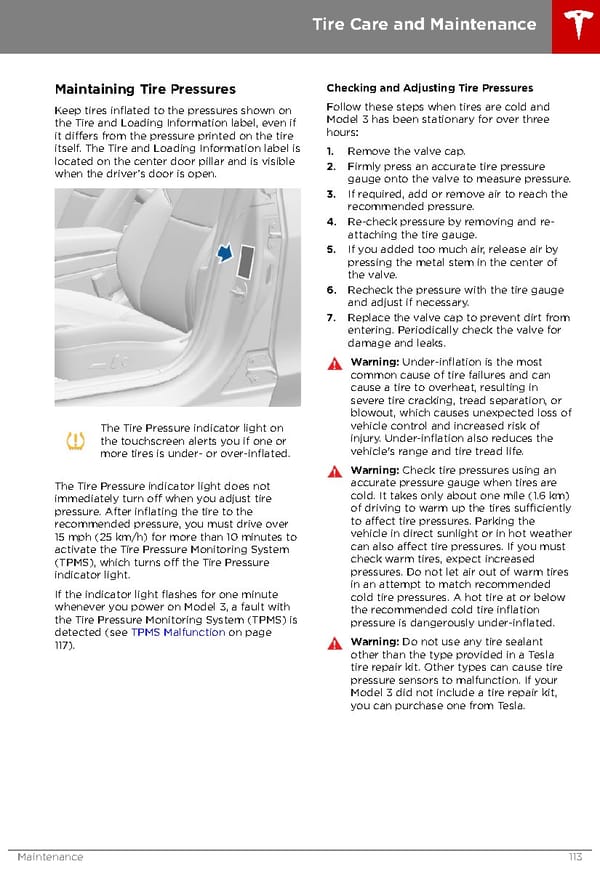Tire Care and Maintenance Maintaining Tire Pressures Checking and Adjusting Tire Pressures Keep tires inflated to the pressures shown on Follow these steps when tires are cold and the Tire and Loading Information label, even if Model 3 has been stationary for over three it differs from the pressure printed on the tire hours: itself. The Tire and Loading Information label is 1. Remove the valve cap. located on the center door pillar and is visible 2. Firmly press an accurate tire pressure when the driver†s door is open. gauge onto the valve to measure pressure. 3. If required, add or remove air to reach the recommended pressure. 4. Re-check pressure by removing and re- attaching the tire gauge. 5. If you added too much air, release air by pressing the metal stem in the center of the valve. 6. Recheck the pressure with the tire gauge and adjust if necessary. 7. Replace the valve cap to prevent dirt from entering. Periodically check the valve for damage and leaks. Warning: Under-inflation is the most common cause of tire failures and can cause a tire to overheat, resulting in severe tire cracking, tread separation, or blowout, which causes unexpected loss of The Tire Pressure indicator light on vehicle control and increased risk of the touchscreen alerts you if one or injury. Under-inflation also reduces the more tires is under- or over-inflated. vehicle's range and tire tread life. Warning: Check tire pressures using an The Tire Pressure indicator light does not accurate pressure gauge when tires are immediately turn off when you adjust tire cold. It takes only about one mile (1.6 km) pressure. After inflating the tire to the of driving to warm up the tires sufficiently recommended pressure, you must drive over to affect tire pressures. Parking the 15 mph (25 km/h) for more than 10 minutes to vehicle in direct sunlight or in hot weather activate the Tire Pressure Monitoring System can also affect tire pressures. If you must (TPMS), which turns off the Tire Pressure check warm tires, expect increased indicator light. pressures. Do not let air out of warm tires If the indicator light flashes for one minute in an attempt to match recommended whenever you power on Model 3, a fault with cold tire pressures. A hot tire at or below the Tire Pressure Monitoring System (TPMS) is the recommended cold tire inflation detected (see TPMS Malfunction on page pressure is dangerously under-inflated. 117). Warning: Do not use any tire sealant other than the type provided in a Tesla tire repair kit. Other types can cause tire pressure sensors to malfunction. If your Model 3 did not include a tire repair kit, you can purchase one from Tesla. Maintenance 113
 Tesla Model 3 | Owner's Manual Page 113 Page 115
Tesla Model 3 | Owner's Manual Page 113 Page 115